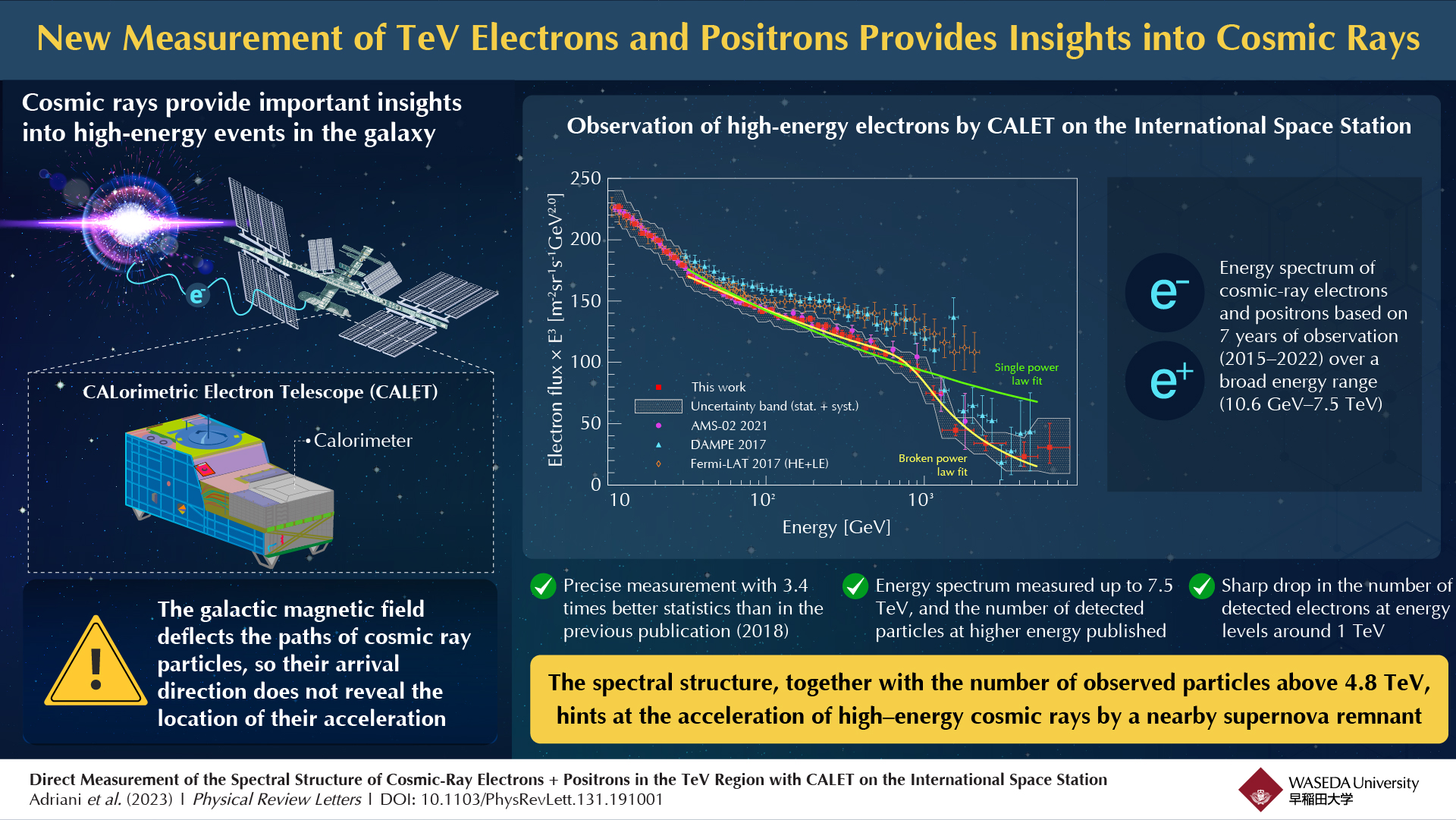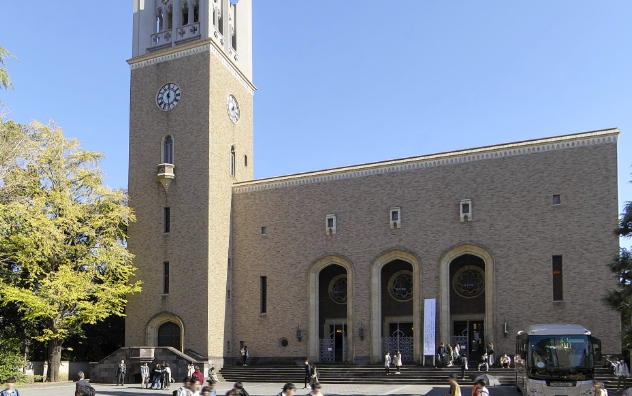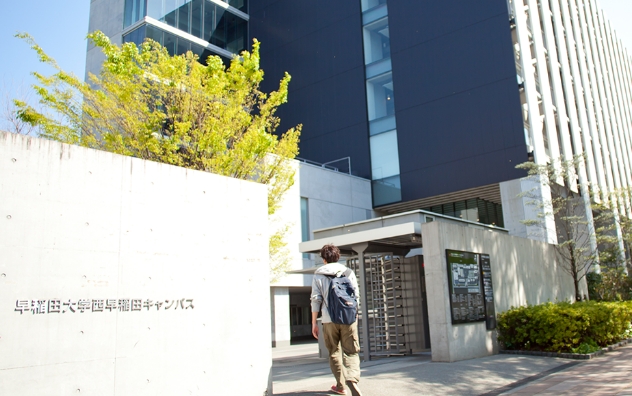CALET Mission Detects Cosmic-Ray Electrons with Energies up to 7.5 TeV
Mon, Dec 25, 2023-
Tags
CALET Mission Detects Cosmic-Ray Electrons with Energies up to 7.5 TeV
The observations represent a significant milestone for cosmic ray detection and the study of high-energy phenomena.
Image title: Energy spectrum of electrons up to 7.5 TeV by CALET.
Image caption: The measurement of the energy spectrum of high-energy cosmic-ray electrons and positrons across a broad energy range from 10.6 GeV–7.5 TeV mark a new first. The observation results suggest the possible existence of nearby high-energy cosmic-ray sources.
Image credit: Yosui Akaike from Waseda University, Japan
Image license: Original content
Usage restrictions: Cannot be reused without permission.
The CALorimetric Electron Telescope (CALET) has played a crucial role in detecting cosmic rays, offering insights into high-energy events in the galaxy. In a new study, an international team of researchers has measured the cosmic ray electron spectrum up to an energy of 7.5 TeV for the first time directly in space. The observation is significant since the spectral structure together with the number of observed particles above 4.8 TeV hints at the acceleration of high energy cosmic rays by a nearby supernova remnant.
Cosmic rays are high-energy subatomic particles, such as protons, electrons, and atomic nuclei, originating from intense events like supernovae explosions. The study of cosmic rays provides a direct window into the high-energy processes occurring in the universe. However, these particles are deflected by interstellar magnetic fields, complicating efforts to identify their origin, since their direction of arrival does not point back at their sources. To overcome this challenge, scientists turn to observations of high-energy electrons with energies above 1 TeV (1 tera electron volt = 1012 electron volts). Unlike other cosmic ray particles like protons and nuclei, high-energy electrons lose energy rapidly during their journey owing to their low mass. This rapid energy loss means that the electrons reaching Earth are likely to originate from nearby sources.
To understand the origin and propagation of high-energy cosmic rays, the Japan Aerospace Exploration Agency (JAXA), in collaboration with research teams from Italy and the USA, established the CALorimetric Electron Telescope (CALET). Positioned onboard the International Space Station (ISS), CALET tracks the type, energy, and arrival direction of cosmic rays. Using data from the CALET mission, scientists have recently successfully measured the energy spectrum of high-energy electrons in the TeV energy range for the first time directly in space.
In this significant milestone, the CALET team, including Researcher (Associate Professor) Yosui Akaike and Emeritus Professor Shoji Torii from Waseda Research Institute for Science and Engineering at Waseda University, Professor Holger Motz from Global Center for Science and Engineering at Faculty of Science and Engineering at Waseda University, and Assistant Research Scientist Nicholas Cannady from Center for Research and Exploration in Space Science and Technology at NASA Goddard Space Flight Center at Maryland University, Baltimore County, presents observations of high-energy cosmic-ray electrons and positrons across a broad energy range spanning tens of GeVs (giga electron volts) to few TeVs (10.6 GeV-7.5 TeV). Their findings, based on seven years of observations from October 13, 2015, to December 31, 2022, have been published in the journal Physical Review Letters on 09 November 2023.
“We have precisely measured the electron spectrum with CALET for energies up to 7.5 TeV, an energy range never directly observed in space,” states Akaike.
For accurate measurements, the researchers used machine learning techniques to isolate high-energy electrons from background protons. Their efforts resulted in the detection of a large number of electrons and positrons, and the precise measurement of their energy. Based on a number of detected particles 3.4 times larger than used for the previous publication in 2018, a more precise energy spectrum was published, which also extends up to 7.5 TeV in energy compared to 4.8 TeV in the previous publication. Moreover, contrary to a gradual decrease in the flux of high-energy electrons following a simple power law fit, the researchers observed a sudden and significant drop in the number of electrons at around 1 TeV. This drop in the number of high-energy electrons supports the concept that the electrons coming from distant parts of space lose most of their energy during their journey. As a result, only a smaller number of electrons originating from the nearby part of space can arrive at Earth with TeV-range energy, giving the energy spectrum a distinctive downward curve.
The observed energy number of high-energy electrons above 4.8 TeV was found to closely match the prediction of a model for the emission of cosmic rays from the nearby Vela supernova remnant, suggesting it as a potential source for these particles. The detection of particles with such high energies marks a crucial achievement as it can offer a more comprehensive understanding of the universe. The researchers plan on continuing their observations to measure the cosmic ray electron spectrum up to energies of 20 TeV.
“Understanding cosmic rays is not only important regarding their origin and nature but also in relation to observations of X-rays, gamma-rays, and other messengers. Hopefully, this research will reveal many mysteries of the high-energy universe,” says Akaike, highlighting the importance of the CALET mission.
Reference
Authors
O. Adriani,1,2 Y. Akaike ,3,4, * K. Asano,5 Y. Asaoka,5 E. Berti,2,6 G. Bigongiari,7,8 W. R. Binns,9 M. Bongi,1,2 P. Brogi,7,8 A. Bruno,10 J. H. Buckley,9 N. Cannady,11,12,13, † G. Castellini,6 C. Checchia,7,8 M. L. Cherry,14 G. Collazuol,15,16 G. A. de Nolfo,10 K. Ebisawa,17 A. W. Ficklin,14 H. Fuke,17 S. Gonzi,1,2,6 T. G. Guzik,14 T. Hams,11 K. Hibino,18 M. Ichimura,19 K. Ioka,20 W. Ishizaki,5 M. H. Israel,9 K. Kasahara,21 J. Kataoka,22 R. Kataoka,23 Y. Katayose,24 C. Kato,25 N. Kawanaka,20 Y. Kawakubo,14 K. Kobayashi,3,4 K. Kohri,26 H. S. Krawczynski,9 J. F. Krizmanic,12 P. Maestro,7,8 P. S. Marrocchesi,7,8 A. M. Messineo,27,8 J. W. Mitchell,12 S. Miyake,28 A. A. Moiseev,29,12,13 M. Mori,30 N. Mori,2 H. M. Motz,18, ‡ K. Munakata,25 S. Nakahira,17 J. Nishimura,17 S. Okuno,18 J. F. Ormes,31 S. Ozawa,32 L. Pacini,2,6 P. Papini,2 B. F. Rauch,9 S. B. Ricciarini,2,6 K. Sakai,11,12,13 T. Sakamoto,33 M. Sasaki,29,12,13 Y. Shimizu,18 A. Shiomi,34 P. Spillantini,1 F. Stolzi,7,8 S. Sugita,33 A. Sulaj,7,8 M. Takita,5 T. Tamura,18 T. Terasawa,5 S. Torii,3,§ Y. Tsunesada,35,36 Y. Uchihori,37 E. Vannuccini,2 J. P. Wefel,14 K. Yamaoka,38 S. Yanagita,39 A. Yoshida,33 K. Yoshida,21 and W. V. Zober9
Title of original paper
Direct Measurement of the Spectral Structure of Cosmic-Ray Electrons + Positrons in the TeV Region with CALET on the International Space Station
Journal
Physical Review Letters
DOI
10.1103/PhysRevLett.131.191001
Affiliations
1 Department of Physics, University of Florence, Via Sansone, 1–50019, Sesto Fiorentino, Italy
2 INFN Sezione di Florence, Via Sansone, 1–50019, Sesto Fiorentino, Italy
3 Waseda Research Institute for Science and Engineering, Waseda University, 17 Kikuicho, Shinjuku, Tokyo 162-0044, Japan
4 JEM Utilization Center, Human Spaceflight Technology Directorate, Japan Aerospace Exploration Agency, 2-1-1 Sengen, Tsukuba, Ibaraki 305-8505, Japan
5 Institute for Cosmic Ray Research, The University of Tokyo, 5-1-5 Kashiwa-no-Ha, Kashiwa, Chiba 277-8582, Japan
6 Institute of Applied Physics (IFAC), National Research Council (CNR), Via Madonna del Piano, 10, 50019, Sesto Fiorentino, Italy
7 Department of Physical Sciences, Earth and Environment, University of Siena, via Roma 56, 53100 Siena, Italy
8 INFN Sezione di Pisa, Polo Fibonacci, Largo B. Pontecorvo, 3–56127 Pisa, Italy
9 Department of Physics and McDonnell Center for the Space Sciences, Washington University, One Brookings Drive, St. Louis, Missouri 63130-4899, USA
10 Heliospheric Physics Laboratory, NASA/GSFC, Greenbelt, Maryland 20771, USA
11 Center for Space Sciences and Technology, University of Maryland, Baltimore County, 1000 Hilltop Circle, Baltimore, Maryland 21250, USA
12 Astroparticle Physics Laboratory, NASA/GSFC, Greenbelt, Maryland 20771, USA
13 Center for Research and Exploration in Space Sciences and Technology, NASA/GSFC, Greenbelt, Maryland 20771, USA
14 Department of Physics and Astronomy, Louisiana State University, 202 Nicholson Hall, Baton Rouge, Louisiana 70803, USA
15 Department of Physics and Astronomy, University of Padova, Via Marzolo, 8, 35131 Padova, Italy
16 INFN Sezione di Padova, Via Marzolo, 8, 35131 Padova, Italy
17 Institute of Space and Astronautical Science, Japan Aerospace Exploration Agency, 3-1-1 Yoshinodai, Chuo, Sagamihara, Kanagawa 252-5210, Japan
18 Kanagawa University, 3-27-1 Rokkakubashi, Kanagawa, Yokohama, Kanagawa 221-8686, Japan
19 Faculty of Science and Technology, Graduate School of Science and Technology, Hirosaki University, 3, Bunkyo, Hirosaki, Aomori 036-8561, Japan
20 Yukawa Institute for Theoretical Physics, Kyoto University, Kitashirakawa Oiwake-cho, Sakyo-ku, Kyoto, 606-8502, Japan
21 Department of Electronic Information Systems, Shibaura Institute of Technology, 307 Fukasaku, Minuma, Saitama 337-8570, Japan
22 School of Advanced Science and Engineering, Waseda University, 3-4-1 Okubo, Shinjuku, Tokyo 169-8555, Japan
23 National Institute of Polar Research, 10-3, Midori-cho, Tachikawa, Tokyo 190-8518, Japan
24 Faculty of Engineering, Division of Intelligent Systems Engineering, Yokohama National University, 79-5 Tokiwadai, Hodogaya, Yokohama 240-8501, Japan
25 Faculty of Science, Shinshu University, 3-1-1 Asahi, Matsumoto, Nagano 390-8621, Japan
26 Institute of Particle and Nuclear Studies, High Energy Accelerator Research Organization, 1-1 Oho, Tsukuba, Ibaraki, 305-0801, Japan
27 University of Pisa, Polo Fibonacci, Largo B. Pontecorvo, 3–56127 Pisa, Italy
28 Department of Electrical and Electronic Systems Engineering, National Institute of Technology (KOSEN), Ibaraki College, 866 Nakane, Hitachinaka, Ibaraki 312-8508, Japan
29 Department of Astronomy, University of Maryland, College Park, Maryland 20742, USA
30 Department of Physical Sciences, College of Science and Engineering, Ritsumeikan University, Shiga 525-8577, Japan
31 Department of Physics and Astronomy, University of Denver, Physics Building, Room211, 2112 East Wesley Avenue, Denver, Colorado 80208-6900, USA
32 Quantum ICT Advanced Development Center, National Institute of Information and Communications Technology, 4-2-1 Nukui-Kitamachi, Koganei, Tokyo 184-8795, Japan
33 College of Science and Engineering, Department of Physics and Mathematics, Aoyama Gakuin University, 5-10-1 Fuchinobe, Chuo, Sagamihara, Kanagawa 252-5258, Japan
34 College of Industrial Technology, Nihon University, 1-2-1 Izumi, Narashino, Chiba 275-8575, Japan
35 Graduate School of Science, Osaka Metropolitan University, Sugimoto, Sumiyoshi, Osaka 558-8585, Japan
36 Nambu Yoichiro Institute for Theoretical and Experimental Physics, Osaka Metropolitan University, Sugimoto, Sumiyoshi, Osaka 558-8585, Japan
37 National Institutes for Quantum and Radiation Science and Technology, 4-9-1 Anagawa, Inage, Chiba 263-8555, Japan
38 Nagoya University, Furo, Chikusa, Nagoya 464-8601, Japan
39 College of Science, Ibaraki University, 2-1-1 Bunkyo, Mito, Ibaraki 310-8512, Japan
About Waseda University
Located in the heart of Tokyo, Waseda University is a leading private research university that has long been dedicated to academic excellence, innovative research, and civic engagement at both the local and global levels since 1882. The University has produced many changemakers in its history, including nine prime ministers and many leaders in business, science and technology, literature, sports, and film. Waseda has strong collaborations with overseas research institutions and is committed to advancing cutting-edge research and developing leaders who can contribute to the resolution of complex, global social issues. The University has set a target of achieving a zero-carbon campus by 2032, in line with the Sustainable Development Goals (SDGs) adopted by the United Nations in 2015.
To learn more about Waseda University, visit https://www.waseda.jp/top/en
About Researcher (Associate Professor) Yosui Akaike from Waseda University
Yosui Akaike is a Researcher (Associate Professor) at the Faculty of Science and Engineering at the Waseda Research Institute for Science and Engineering (RISE) at Waseda University in Japan. His research interests include experimental studies related to particle physics, nuclear physics, cosmic rays, and astrophysics. He has published 85 research papers so far, which have been cited over 900 times.
- Links
-
- Helium Nuclei Research Advances Our Understanding of Cosmic Ray Origin and Propagation
- Waseda University Researchers Measure Boron Flux in High-Energy Cosmic Rays with the CALorimetric Electron Telescope (CALET)
- Cosmic Ray Protons Reveal New Spectral Structures at High Energies
- Spectral Measurement of the Iron and Nickel Components of Cosmic Rays at the Highest Energy Ranges
- CALorimetric Electron Telescope (CALET) on the ISS















